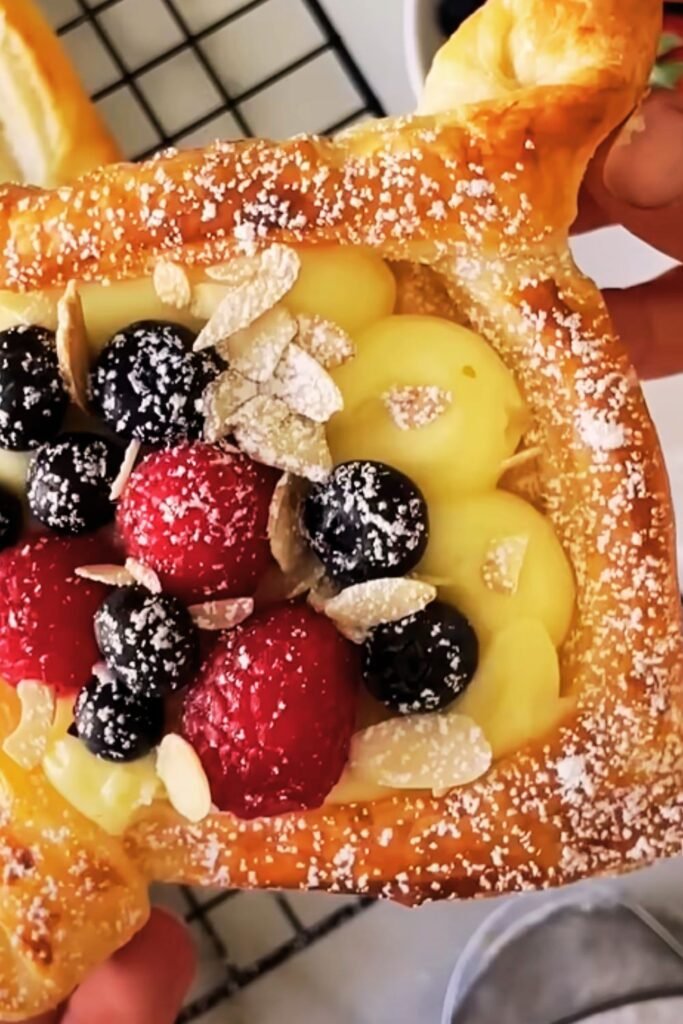There’s something utterly magical about biting into a perfectly made Danish pastry. The flaky layers, the sweet filling, the delicate balance of flavors – it’s a sensory experience unlike any other. Today, I’m excited to share one of my absolute favorite Danish treats: Lagkagesnegle, or as they’re sometimes called in English, Raspberry Swirls with Vanilla Pastry Cream.
These delightful spiral pastries hold a special place in Danish bakery culture, combining buttery laminated dough with luscious vanilla cream and tangy raspberry jam. After years of perfecting my technique, I’m thrilled to guide you through creating these gorgeous treats in your own kitchen.
What Are Lagkagesnegle?
Before we dive into the recipe, let’s talk about what makes these pastries so special. “Lagkagesnegle” breaks down into two Danish words: “lagkage” meaning layer cake, and “snegle” meaning snails – referring to their distinctive spiral shape. These pastries essentially capture the flavors of a traditional Danish layer cake (often served for birthdays) in a convenient hand-held form.
Traditional lagkagesnegle feature layers of buttery Danish pastry dough swirled with vanilla pastry cream and raspberry jam, then topped with a sweet glaze and sometimes sprinkled with coconut flakes. They’re popular throughout Denmark, where you’ll find them in virtually every bakery.
The History Behind These Danish Delights
Danish pastry (known as “wienerbrød” in Denmark) has an interesting origin story. Despite the name, these techniques were actually brought to Denmark by Austrian bakers in the 1850s. Over time, Danish bakers adapted and perfected the lamination process, creating their own distinctive style that emphasizes butter content and unique shapes.
Lagkagesnegle emerged as bakers sought to recreate the beloved flavors of Danish celebration cakes in a more convenient, everyday format. The combination of vanilla and raspberry is deeply rooted in Danish culinary tradition, featured prominently in their famous layer cakes for generations.
Now, let’s get to baking!
Essential Ingredients for Perfect Lagkagesnegle
For the best results, quality ingredients make all the difference:
Danish Pastry Dough
- 500g all-purpose flour (preferably European-style with higher protein content)
- 50g granulated sugar
- 10g salt
- 7g instant dry yeast
- 80ml warm milk
- 2 large eggs, room temperature
- 60ml cold water
- 1 teaspoon vanilla extract
- 250g cold European-style butter (with at least 82% fat content)
Vanilla Pastry Cream
- 500ml whole milk
- 1 vanilla bean, split and seeds scraped (or 2 teaspoons vanilla bean paste)
- 100g granulated sugar
- 40g cornstarch
- 4 egg yolks
- 25g unsalted butter
- Pinch of salt
Raspberry Filling
- 300g fresh or frozen raspberries
- 100g granulated sugar
- 2 tablespoons lemon juice
- 2 tablespoons cornstarch mixed with 2 tablespoons cold water
Glaze
- 200g powdered sugar
- 3-4 tablespoons milk
- 1/2 teaspoon vanilla extract
Optional Toppings
- 50g desiccated coconut
- Fresh raspberries for garnish
Equipment You’ll Need

- Stand mixer with dough hook (or strong arms for kneading!)
- Rolling pin
- Bench scraper
- Baking sheets
- Parchment paper
- Pastry brush
- Saucepan
- Whisk
- Spatula
- Sharp knife or pastry wheel
- Piping bag with round tip (for the pastry cream)
Step-by-Step Instructions
Preparing the Danish Pastry Dough (Day 1)
- In the bowl of your stand mixer, combine flour, sugar, salt, and yeast.
- Add warm milk, eggs, cold water, and vanilla. Mix with the dough hook on low speed until ingredients come together.
- Increase speed to medium and knead for about 5 minutes until you have a smooth, elastic dough.
- Shape into a square about 1-inch thick, wrap in plastic, and refrigerate for at least 1 hour.
- While the dough chills, prepare your butter block. Place the cold butter between two sheets of parchment paper and beat with a rolling pin to create a 6×6 inch square. Refrigerate until needed.
- After the dough has chilled, roll it out on a lightly floured surface into a 9×9 inch square.
- Place the butter block diagonally in the center of the dough square, so the corners of the butter face the sides of the dough.
- Fold the corners of the dough over the butter, sealing it completely inside.
- Now begins the lamination process: Roll the dough into a rectangle approximately 8×16 inches.
- Fold the dough in thirds, like a business letter (this is called a “single fold”).
- Wrap and refrigerate for 1 hour.
- Repeat the rolling and folding process two more times, chilling the dough for 1 hour between each fold.
- After the final fold, wrap the dough tightly and refrigerate overnight.
Making the Vanilla Pastry Cream (Can be done Day 1)
- In a medium saucepan, heat milk with the vanilla bean and seeds (or vanilla paste) until steaming but not boiling.
- Meanwhile, in a bowl, whisk together sugar, cornstarch, egg yolks, and salt until pale and thick.
- Slowly pour about 1/3 of the hot milk into the egg mixture, whisking constantly to prevent curdling.
- Pour the tempered egg mixture back into the remaining hot milk in the saucepan.
- Cook over medium heat, whisking constantly, until the mixture thickens and comes to a boil. Let it boil for 1 minute.
- Remove from heat and stir in the butter until melted and incorporated.
- Transfer to a clean bowl, press plastic wrap directly onto the surface to prevent a skin from forming, and refrigerate until completely cold.
Preparing the Raspberry Filling (Day 1 or 2)
- In a medium saucepan, combine raspberries, sugar, and lemon juice.
- Cook over medium heat until the berries break down and release their juices, about 5-7 minutes.
- Stir in the cornstarch slurry and continue cooking until the mixture thickens, about 1-2 minutes.
- Transfer to a bowl, cover with plastic wrap, and refrigerate until cold.
Assembling and Baking the Lagkagesnegle (Day 2)
- Remove the chilled dough from the refrigerator and let it sit at room temperature for about 10 minutes to make it easier to roll.
- Roll the dough on a lightly floured surface into a rectangle approximately 16×20 inches and 1/8 inch thick.
- Take the chilled vanilla pastry cream and stir it vigorously to smooth it out. Transfer to a piping bag.
- Pipe the vanilla pastry cream evenly across the dough, leaving a 1-inch border at the top edge.
- Spread the raspberry filling over the vanilla cream in an even layer.
- Starting from the long edge closest to you, tightly roll the dough away from you into a log.
- Using a sharp knife or pastry wheel, cut the log into 1-inch thick slices.
- Place the slices, cut side up, on parchment-lined baking sheets, leaving about 2 inches between each one.
- Cover loosely with plastic wrap and let rise in a warm place for about 1-2 hours, until puffy.
- Preheat your oven to 375°F (190°C).
- Bake the pastries for 18-22 minutes, until golden brown.
- Transfer to a wire rack to cool slightly while you prepare the glaze.
Finishing Touches
- For the glaze, whisk together powdered sugar, milk, and vanilla until smooth. The consistency should be thick but pourable.
- Drizzle or spread the glaze over the still-warm pastries.
- If desired, sprinkle with desiccated coconut while the glaze is still wet.
- Allow to cool completely before serving.
Tips for Pastry Perfection

- Temperature is key: Keep your dough and butter cold throughout the lamination process. If at any point the butter starts to soften or leak out, return everything to the refrigerator immediately.
- Take your time: Danish pastry is not something to rush. The resting periods between folds are essential for developing flavor and ensuring proper lamination.
- Don’t overfill: While it’s tempting to load up on fillings, too much will make your pastries messy and difficult to roll.
- Even cuts: Use a very sharp knife or pastry wheel and clean it between cuts for the neatest slices.
- Proper spacing: These pastries will expand significantly during proofing and baking, so give them plenty of room on the baking sheet.
Common Challenges and Solutions
Danish pastry can be tricky, but I’ve encountered all the common problems and found solutions:
| Problem | Cause | Solution |
|---|---|---|
| Butter leaking during baking | Dough or butter too warm | Keep everything cold; chill pastries before baking |
| Dough tears during rolling | Gluten too developed or dough too cold | Rest dough longer; let it warm slightly before rolling |
| Pastries flatten while baking | Underproofed or overproofed | Ensure proper proofing time (should be puffy but not doubled) |
| Pastry cream too runny | Undercooked or improper ratio | Cook until properly thickened; follow measurements exactly |
| Uneven layers | Uneven rolling or folding | Take time to roll evenly; use guides if needed |
| Dense texture | Insufficient lamination | Complete all folds as directed; maintain proper temperature |
| Doughy centers | Underbaked | Check for golden brown color; test center with toothpick |
| Filling leaks out | Too much filling or improper sealing | Use less filling; seal edges well |
Variations to Try
While traditional lagkagesnegle feature raspberry and vanilla, you can experiment with different flavors:
- Lemon Blueberry: Replace raspberry jam with blueberry and add lemon zest to the pastry cream
- Chocolate Hazelnut: Spread a thin layer of chocolate-hazelnut spread under the vanilla cream
- Almond: Add almond extract to the pastry cream and sprinkle with sliced almonds instead of coconut
- Apple Cinnamon: Spread a layer of cinnamon-spiced apple compote in place of the raspberry
- Rhubarb: Use a rhubarb compote for a more tangy, seasonal option
Make-Ahead and Storage Tips
These pastries take time to make, but you can break down the process:
- The Danish dough can be refrigerated for up to 3 days or frozen for up to 1 month.
- Pastry cream keeps well in the refrigerator for up to 3 days.
- Raspberry filling can be made up to 5 days ahead and stored in the refrigerator.
- Baked and glazed pastries are best eaten the same day but will keep for 2 days in an airtight container at room temperature.
- Unglazed baked pastries can be frozen for up to 1 month. Thaw at room temperature and warm slightly in the oven before glazing and serving.
Serving Suggestions

In Denmark, lagkagesnegle are often enjoyed as part of “hygge” – that cozy, comfortable feeling of contentment and well-being. Here’s how I recommend serving them:
- With a cup of strong, hot coffee for breakfast or afternoon fika
- Alongside fresh berries for a weekend brunch
- With hot chocolate topped with whipped cream for a special treat
- As part of a pastry board with other Danish specialties
- For dessert with a scoop of vanilla ice cream
- With a glass of sparkling water with lemon to balance the sweetness
Why These Danish Pastries Are Worth the Effort
Making proper Danish pastry at home is admittedly labor-intensive, but the results are incomparable to anything store-bought. The process of creating those delicate, buttery layers is almost meditative, and there’s nothing quite like the pride of pulling a perfectly baked tray of golden, flaky pastries from your oven.
When you bite into a homemade lagkagesnegle, you’ll experience the incredible contrast between the crisp, caramelized exterior and the soft, tender interior. The vanilla pastry cream adds a luxurious richness while the raspberry jam provides a perfect tangy counterpoint. It’s truly one of the most rewarding baking projects you can undertake.
Nutritional Information
For those watching their intake, here’s an approximate nutritional breakdown per pastry:
| Nutrient | Amount |
|---|---|
| Calories | 380 |
| Total Fat | 21g |
| Saturated Fat | 13g |
| Cholesterol | 120mg |
| Sodium | 230mg |
| Total Carbohydrates | 42g |
| Dietary Fiber | 1g |
| Sugars | 22g |
| Protein | 5g |
Q&A Section
Q: Can I use store-bought puff pastry instead of making Danish dough from scratch?
While you can use puff pastry in a pinch, it won’t give you the authentic lagkagesnegle experience. Danish dough contains yeast and has a different structure and flavor than puff pastry. If you’re short on time, look for ready-made Danish dough rather than puff pastry.
Q: My kitchen is quite warm. Any tips for keeping the dough cold during the lamination process?
Working in a warm kitchen can be challenging for Danish pastry! I recommend working in shorter bursts—roll and fold quickly, then return the dough to the refrigerator immediately. You can also chill your work surface by placing ice packs or frozen gel packs on it for a few minutes before rolling. Some bakers even place their rolling pin in the freezer between uses.
Q: Can I make these without a stand mixer?
Absolutely! Danish dough was made by hand long before stand mixers existed. You’ll need to knead the dough by hand for about 10-12 minutes until smooth and elastic. The process takes a bit more effort but can be quite therapeutic.
Q: My pastry cream has lumps. Can I save it?
Yes! If you catch lumps forming while cooking, immediately remove the pan from heat and whisk vigorously. If that doesn’t work, strain the pastry cream through a fine-mesh sieve while it’s still hot. For stubborn lumps, you can also use an immersion blender (carefully, to avoid incorporating air).
Q: How do I know when my lagkagesnegle are properly proofed before baking?
Properly proofed pastries should look puffy and have increased in size by about 50% (not quite doubled). If you gently press a finger into the dough, it should slowly spring back but leave a slight indentation. If it springs back completely, they need more time. If the indentation remains, they’re overproofed.
Q: Can I prepare these entirely the day before and bake in the morning?
You can shape the pastries and place them on baking sheets, then refrigerate overnight (covered with plastic wrap). In the morning, remove them from the refrigerator and let them complete their final rise at room temperature before baking. This may take 1-2 hours depending on how cold they are.
Q: Why did my layers disappear during baking?
This typically happens when the butter melts before the dough sets in the oven. Make sure your pastries are properly chilled before baking, your oven is fully preheated, and you’re baking at the correct temperature. An oven thermometer can help ensure your oven is accurately calibrated.
Q: My raspberry filling is too runny. How can I fix it?
If your filling is too thin, you can cook it longer to reduce it further or add a bit more cornstarch slurry. Remember that it will thicken more as it cools. If it’s already cold and still too runny, you can reheat it with an additional teaspoon of cornstarch mixed with water.
A Final Note
Making lagkagesnegle at home connects you to a rich Danish baking tradition that has been perfected over generations. While the process requires patience and attention to detail, the reward is a truly exceptional pastry that would make any Danish baker proud.
I find there’s something deeply satisfying about mastering this technique—watching simple ingredients transform into something so spectacularly delicious through nothing but time and careful handling. Each time I make these pastries, I discover something new about the process.
So set aside a weekend, embrace the rhythm of folding and turning, and prepare to fall in love with these beautiful raspberry swirls. Your kitchen will be filled with the most intoxicating buttery, vanilla-scented aroma, and your family and friends will be utterly impressed by your baking prowess.
Happy baking, and as the Danes would say, “Velbekomme!” – Enjoy your meal!